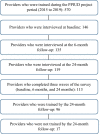Assessing knowledge, attitudes, and practice of health providers towards the provision of postpartum intrauterine devices in Nepal: a two-year follow-up
- PMID: 33596937
- PMCID: PMC7891136
- DOI: 10.1186/s12978-021-01099-7
Assessing knowledge, attitudes, and practice of health providers towards the provision of postpartum intrauterine devices in Nepal: a two-year follow-up
Abstract
Background: Health service providers play a key role in addressing women's need for postpartum pregnancy prevention. Yet, in Nepal, little is known about providers' knowledge, attitudes, and practice (KAP) on providing postpartum family planning (PPFP), particularly the immediate postpartum intrauterine device (PPIUD). This paper assesses providers KAP towards the provision of PPIUDs in Nepal prior to a PPIUD intervention to gain a baseline insight and analyzes whether their KAP changes both 6 and 24 months after the start of the intervention.
Methods: Data come from a randomized trial assessing the impact of a PPIUD intervention in Nepal between 2015 and 2017. We interviewed 96 providers working in six study hospitals who completed a baseline interview and follow-up interviews at 6 and 24 months. We used descriptive analysis, McNemar's test and the Wilcoxon signed-rank test to assess KAP of providers over 2 years.
Results: The PPIUD KAP scores improved significantly between the baseline and 6-month follow-up. Knowledge scores increased from 2.9 out of 4 to 3.5, attitude scores increased from 4 out of 7 to 5.3, and practice scores increased from 0.9 out of 3 to 2.8. There was a significant increase in positive attitude and practice between 6 and 24 months. Knowledge on a women's chance of getting pregnant while using an IUD was poor. Attitudes on recommending a PPIUD to different women significantly improved, however, attitudes towards recommending a PPIUD to unmarried women and women who have had an ectopic pregnancy improved the least. Practice of PPIUD counseling and insertion improved significantly from baseline to 24 months, from 10.4 and 9.4% to 99% respectively.
Conclusions: Although KAP improved significantly among providers during the PPIUD intervention, providers' knowledge on a women's chance of getting pregnant while using an IUD and attitudes towards recommending a PPIUD to unmarried women and women who have had an ectopic pregnancy improved the least. Provider KAP could be improved further through ongoing and more in-depth training to maintain providers' knowledge, reduce provider bias and misconceptions about PPIUD eligibility, and to ensure providers understand the importance of birth spacing.
Keywords: Attitudes; Health providers; KAP; Knowledge; Nepal; Postpartum IUD; Postpartum family planning; Practice.
Conflict of interest statement
The authors declare that they have no competing interests.
Similar articles
-
Delivering postpartum family planning services in Nepal: are providers supportive?BMC Health Serv Res. 2018 Dec 6;18(1):948. doi: 10.1186/s12913-018-3777-3. BMC Health Serv Res. 2018. PMID: 30522481 Free PMC article. Clinical Trial.
-
Integrating postpartum contraceptive counseling and IUD insertion services into maternity care in Nepal: results from stepped-wedge randomized controlled trial.Reprod Health. 2019 May 29;16(1):69. doi: 10.1186/s12978-019-0738-1. Reprod Health. 2019. PMID: 31142344 Free PMC article. Clinical Trial.
-
Reinvigorating postpartum intrauterine contraceptive device use in Pakistan: an observational assessment of competency-based training of health providers using low-cost simulation models.BMC Med Educ. 2019 Jul 15;19(1):261. doi: 10.1186/s12909-019-1683-y. BMC Med Educ. 2019. PMID: 31307460 Free PMC article.
-
Patients and providers' knowledge, attitudes, and beliefs regarding immediate postpartum long-acting reversible contraception: a systematic review.Women Health. 2020 Feb;60(2):179-196. doi: 10.1080/03630242.2019.1616042. Epub 2019 May 23. Women Health. 2020. PMID: 31122167
-
Immediate Postpartum Intrauterine Contraception Insertion.Obstet Gynecol Clin North Am. 2015 Dec;42(4):569-82. doi: 10.1016/j.ogc.2015.08.001. Obstet Gynecol Clin North Am. 2015. PMID: 26598300 Review.
Cited by
-
Knowledge, Attitude, and Practice of Brazilian Physicians about Immediate Postpartum and Postabortion Intrauterine Device Insertion.Rev Bras Ginecol Obstet. 2023 Sep;45(9):e524-e534. doi: 10.1055/s-0043-1772187. Epub 2023 Oct 16. Rev Bras Ginecol Obstet. 2023. PMID: 37846185 Free PMC article.
-
Integrating postpartum IUD counselling and insertion into routine maternity care in Nepal: Assessing trends over time.PLOS Glob Public Health. 2023 Mar 22;3(3):e0001665. doi: 10.1371/journal.pgph.0001665. eCollection 2023. PLOS Glob Public Health. 2023. PMID: 36963067 Free PMC article.
-
Clinician and policymaker perspectives on the barriers and enablers to implementing and scaling up integrated postpartum intrauterine contraceptive services within maternity care in Nepal: a qualitative study.Lancet Reg Health Southeast Asia. 2025 May 14;37:100599. doi: 10.1016/j.lansea.2025.100599. eCollection 2025 Jun. Lancet Reg Health Southeast Asia. 2025. PMID: 40487913 Free PMC article.
-
Effect of Package of Interventions on the Use and Quality of Postpartum Family Planning Services at Yekatit 12 Hospital Medical College (Y12HMC), Addis Ababa, Ethiopia.Health Serv Insights. 2023 Mar 10;16:11786329231160017. doi: 10.1177/11786329231160017. eCollection 2023. Health Serv Insights. 2023. PMID: 36923261 Free PMC article.
References
-
- World Health Organization (WHO). Report of a WHO Consultation on Birth Spacing, Geneva: WHO; 2005. https://apps.who.int/iris/bitstream/handle/10665/69855/WHO_RHR_07.1_eng..... Accessed 23 Jul 2020.
-
- Moore Z, Pfitzer A, Gubin R, Charurat E, Elliott L, Croft T. Missed opportunities for family planning: an analysis of pregnancy risk and contraceptive method use among postpartum women in 21 low- and middle-income countries. Contraception. 2015;92:31–39. doi: 10.1016/j.contraception.2015.03.007. - DOI - PubMed
MeSH terms
LinkOut - more resources
Full Text Sources
Other Literature Sources
Medical


